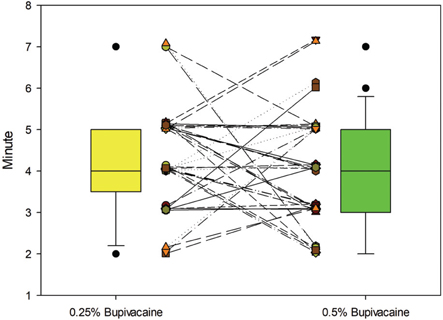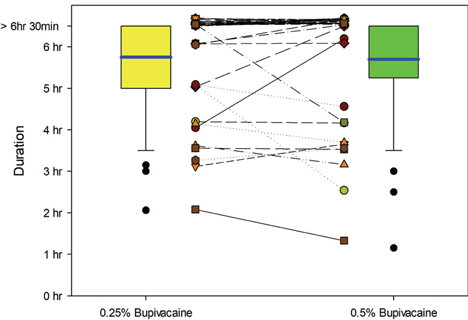J Dent Anesth Pain Med.
2019 Aug;19(4):209-215. 10.17245/jdapm.2019.19.4.209.
An in vivo study comparing efficacy of 0.25% and 0.5% bupivacaine in infraorbital nerve block for postoperative analgesia
- Affiliations
-
- 1Department of Oral and Maxillofacial Surgery, Dr. D.Y. Patil Vidyapeeth, Pune, Maharashtra, India. sonalbshah@rediffmail.com
- KMID: 2456012
- DOI: http://doi.org/10.17245/jdapm.2019.19.4.209
Abstract
- BACKGROUND
Pain is an unpleasant sensation ranging from mild localized discomfort to agony and is one of the most commonly experienced symptoms in oral surgery. Usually, local anesthetic agents and analgesics are used for pain control in oral surgical procedures. Local anesthetic agents including lignocaine and bupivacaine are routinely used in varying concentrations. The present study was designed to evaluate and compare the efficacy of 0.25% and 0.5% bupivacaine for postoperative analgesia in infraorbital nerve block.
METHODS
Forty-one patients undergoing bilateral maxillary orthodontic extraction received 0.5% bupivacaine (n = 41) on one side and 0.25% bupivacaine (n = 41) on the other side at an interval of 7 d. The parameters evaluated for both the bupivacaine concentrations were onset of action, pain during procedure (visual analog scale score [VAS]), and duration of action. The results were noted, tabulated, and analyzed using the Wilcoxon signed rank test.
RESULTS
The onset of action of 0.5% bupivacaine was quicker than that of 0.25% bupivacaine, but the difference was not statistically significant (P = 0.306). No significant difference was found between the solutions for VAS scores (P = 0.221) scores and duration of action (P = 0.662).
CONCLUSION
There was no significant difference between 0.25% bupivacaine and 0.5% bupivacaine in terms of onset of action, pain during procedure, and duration of action. The use of 0.25% bupivacaine is recommended.
MeSH Terms
Figure
Reference
-
1. Mishra A, Mahajan M, Bande C, Joshi A, Gawande M, Gupta MK. Is amalgamated ligno-bupivacaine an answer to complicated minor oral surgical anesthesia? A randomized split-mouth double-blind clinical trial. Oral Maxillofac Surg. 2018; 22:97–104.
Article2. Ekenstam B Af, Egner B, Pettersson G. N-alkyl pyrrolidine and N-alkyl piperidine carboxylic acid amides. Acta Chem Scand. 1957; 11:1183–1190.3. Chapman PJ. A controlled comparison of effectiveness of bupivacaine for post-operative pain control. Aust Dent J. 1988; 33:288–290.
Article4. Malamed SF. Handbook of local anesthesia. 5th ed. St. Louis: Mosby;2004. p. 73–74.5. Chapman PJ, Macleod AW. A Clinical Study of Bupivacaine for Mandibular Anesthesia in Oral Surgery. Anesth Prog. 1985; 32:69–72.6. Monheim , Leonard M, Bennett CR. Monheim's Local Anesthesia and Pain Control in Dental Practice. 7th ed. St. Louis: Mosby;1984. p. 154–156.7. Thakare A, Bhate K, Kathariya R. Comparison of 4% articaine and 0.5% bupivacaine anesthetic efficacy in orthodontic extractions: prospective, randomized crossover study. Acta Anaesthesiol Taiwan. 2014; 52:59–63.
Article8. Moradi S, Naghavi N. Comparison of bupivacaine and lidocaine use for postoperative pain control in endodontics. Iran Endod J. 2010; 5:31–35.9. Su N, Wang H, Zhang S, Liao S, Yang S, Huang Y. Efficacy and safety of bupivacaine versus lidocaine in dental treatments: a meta-analysis of randomised controlled trials. Int Dent J. 2014; 64:34–45.
Article10. Vílchez-Pérez MA, Sancho-Puchades M, Valmaseda-Castellón E, Paredes-García J, Berini-Aytés L, Gay-Escoda C. A prospective, randomized, triple-blind comparison of articaine and bupivacaine for maxillary infiltrations. Med Oral Patol Oral Cir Bucal. 2012; 17:e325–e330.11. Gross R, McCartney M, Reader A, Beck M. A Prospective, Randomized, Double-blind Comparison of Bupivacaine and Lidocaine for Maxillary Infiltrations. J Endod. 2007; 33:1021–1024.
Article12. Sampaio RM, Carnaval TG, Lanfredi CB, Horliana AC, Rocha RG, Tortamano IP. Comparison of the anesthetic efficacy between bupivacaine and lidocaine in patients with irreversible pulpitis of mandibular molar. J Endod. 2012; 38:594–597.
Article13. Brajković D, Biočanin V, Milič M, Vučetić M, Petrović R, Brković B. Quality of analgesia after lower third molar surgery: A randomised, double-blind study of levobupivacaine, bupivacaine and lidocaine with epinephrine. Vojnosanit Pregl. 2015; 72:50–56.
Article14. Nespeca JA. Clinical trials with bupivacaine in oral surgery. Oral Surg Oral Med Oral Pathol. 1976; 42:301–307.
Article15. Balakrishnan K, Ebenezer V, Dakir A, Kumar S, Prakash D. Bupivacaine versus lignocaine as the choice of local anesthetic agent for impacted third molar surgery a review. J Pharm Bioallied Sci. 2015; 7:S230–S233.16. Moore PA. Bupivacaine: A long-lasting local anesthetic for dentistry. Oral Surg Oral Med Oral Pathol. 1984; 58:369–374.
Article17. de Souza AM, Horliana AC, Simone JL, Jorge WA, Tortamano IP. Postoperative pain after bupivacaine supplementation in mandibular third molar surgery: split-mouth randomized double blind controlled clinical trial. Oral Maxillofac Surg. 2014; 18:387–391.
Article18. Fox MG, Patrie JT. Does Reducing the Concentration of Bupivacaine When Performing Therapeutic Shoulder Joint Injections Impact the Clinical Outcome? AJR Am J Roentgenol. 2016; 206:805–809.
Article19. Iamaroon A, Tangwiwat S, Sirivanasandha B, Halilamien P, Lertpenmetha Y, Sirimaneewattana S, et al. Femoral nerve block using 0.25% or 0.5% bupivacaine for analgesia after arthroscopic anterior cruciate ligament reconstruction. J Med Assoc Thai. 2014; 97:717–723.20. Palma A, Viegas J, Manlhiot C, McCrindle B, Benson L. Use of local anesthetic (0.25% bupivacaine) for pain control after pediatric cardiac catheterization: A randomized controlled trial. Catheter Cardiovasc Interv. 2016; 87:318–323.
Article21. de Lima E Souza R, Correa CH, Henriques MD, de Oliveira CB, Nunes TA, Gomez RS. Single-injection femoral nerve block with 0.25% ropivacaine or 0.25% bupivacaine for postoperative analgesia after total knee replacement or anterior cruciate ligament reconstruction. J Clin Anesth. 2008; 20:521–527.
Article22. Mulroy MF, Larkin KL, Batra MS, Hodgson PS, Owens BD. Femoral nerve block with 0.25% or 0.5% bupivacaine improves postoperative analgesia following outpatient arthroscopic anterior cruciate ligament repair. Reg Anesth Pain Med. 2001; 26:24–29.
Article23. Bouloux GF, Punnia-Moorthy A. Bupivacaine versus lidocaine for third molar surgery: a double-blind, randomized, crossover study. J Oral Maxillofac Surg. 1999; 57:510–514.
Article24. Nielsen TH, Kristoffersen E, Olsen KH, Larsen HV, Husegaard HC, Wernberg M. Plain bupivacaine: 0.5% or 0.25% for spinal analgesia? Br J Anaesth. 1989; 62:164–167.
Article25. Lyons GR, Kocarev MG, Wilson RC, Columb MO. A comparison of minimum local anesthetic volumes and doses of epidural bupivacaine (0.125% w/v and 0.25% w/v) for analgesia in labor. Anesth Analg. 2007; 104:412–415.
Article26. Dhanrajani P, Chung P. Comparative study of analgesia with bupivacaine 0.25% versus 0.5% for third molar removal under general anesthesia. J Dent Anesth Pain Med. 2016; 16:117–122.
Article27. Kaya Z, Süren M, Arici S, Karaman S, Tapar H, Erdemir F. Prospective, randomized, double-blinded comparison of the effects of caudally administered levobupivacaine 0.25% and bupivacaine 0.25% on pain and motor block in children undergoing circumcision surgery. Eur Rev Med Pharmacol Sci. 2012; 16:2014–2020.
- Full Text Links
- Actions
-
Cited
- CITED
-
- Close
- Share
- Similar articles
-
- A Case of Pre- and Postoperative Analgesia by Continuous 3-in-1 Nerve Block in Patient with Femoral Neck Fracture
- A Comparison between Ilioinguinal and Iliohypogastric Nerve Block and Infiltration of Local Anesthetics for Postoperative Pain after Inguinal Herniorrhaphy in Children
- Continuous Postoperative Regional Analgesia By Nerve Sheath Block For Limb Amputation Surgery
- The effect of femoral nerve block combined with intravenous patient-controlled analgesia after a unilateral total knee replacement
- Ultrasound-guided trans-incisional quadratus lumborum block versus ultrasound-guided caudal analgesia in pediatric open renal surgery: a randomized trial



